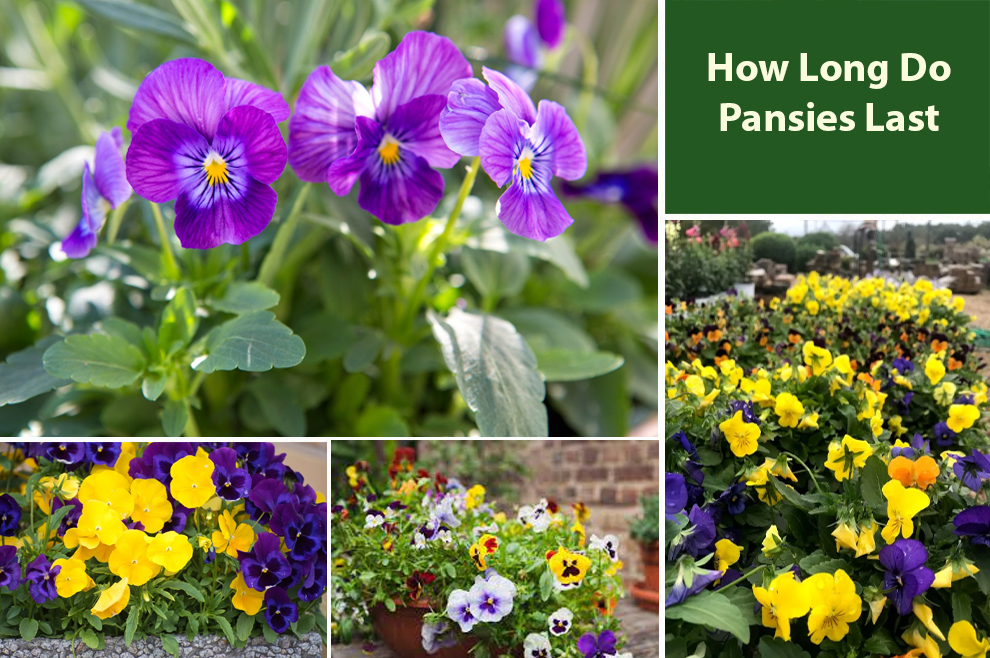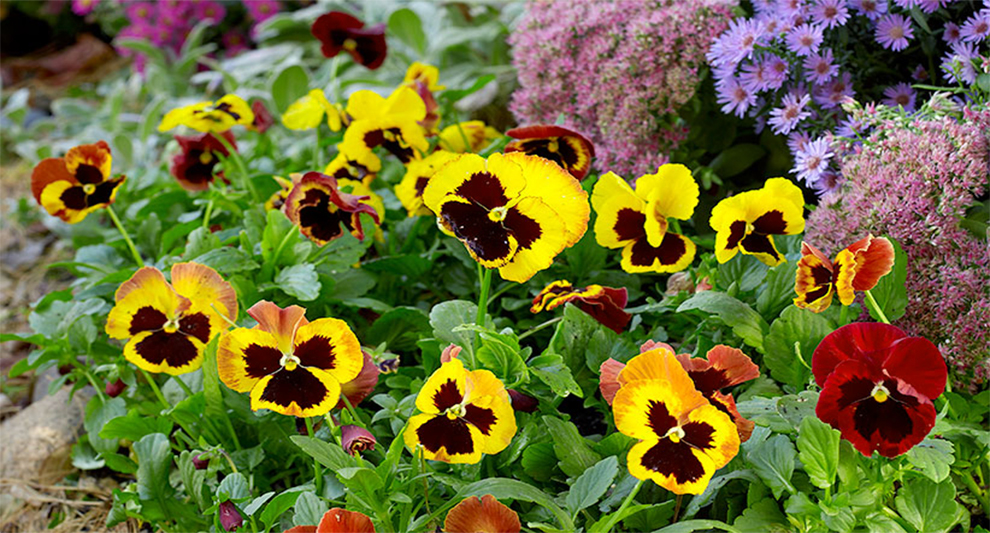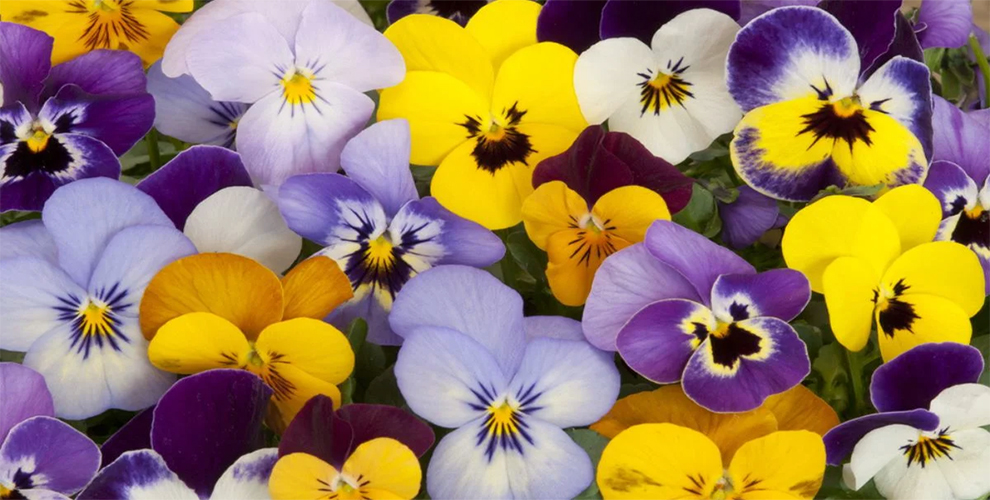Pansies Lifespan: How Long do Pansies Live?
Pansy flowers usually bloom for about 1-2 weeks on average. Pansies are mostly annual plants that live for one season. However, some pansies may be short-lived perennials too.

Pansies are delightful and colorful flowering plants that capture the hearts of gardeners and flower enthusiasts. Their vibrant blooms make them a popular choice for gardens, borders, containers, and window boxes.
Pansies exhibit a moderate lifespan, typically lasting for a single growing season. They are commonly grown as annuals or short-lived perennials, depending on the climate and region.
How long do pansies last i.e., the lifespan of individual pansy flowers varies, with blooms generally lasting for about 1 to 2 weeks.
However, the specific duration can be influenced by several factors. Temperature, sunlight exposure, watering practices, and overall plant health all play a role in determining the lifespan of a pansy flower.
By providing proper care, such as regular watering, deadheading, and suitable environmental conditions, you can help extend the flowering period of pansies.
Are Pansies Perennials?
The answer is no and yes. Pansies are typically grown as annuals or short-lived perennials. In milder climates, they may survive and bloom throughout the winter, acting as perennials.
However, pansies are mostly treated as annuals in colder regions where they cannot withstand freezing temperatures. Gardeners in these areas often replant them each year to enjoy their vibrant colors during the cooler seasons.
Despite the relatively short lifespan of each flower, pansies are prolific bloomers. They have the remarkable ability to continuously produce new blooms throughout the growing season. This trait ensures a consistent display of vibrant colors, adding beauty and charm to any outdoor space.
With a wide variety of pansy cultivars available, including early-flowering varieties, heat-tolerant types, and disease-resistant selections, you can tailor your choices to suit your specific climate and preferences.
By selecting appropriate varieties and providing optimal care, you can maximize pansies lifespan, witnessing their stunning blooms for weeks on end.
Whether you choose to adorn your garden with pansies for a burst of color in spring, fall, or even winter in milder regions, these charming flowers are sure to bring joy and beauty to your outdoor space.
The Lifespan of Pansies in Different Seasons

The overall average lifespan of pansies can vary depending on the seasons and environmental conditions.
Here’s a general overview of pansy lifespan in different seasons:
How Long Do Pansies Last In The Summer?
Pansies are not well-suited for hot summer temperatures. In many regions, pansies struggle to survive or even perish during the intense heat of summer. The lifespan of pansies in summer can be relatively short, and their flowering may dwindle significantly.
How Long Do Winter Pansies Last?
Pansies are typically not considered winter-hardy in regions with severe colds. Freezing temperatures and harsh winter conditions can damage or kill pansies.
However, in milder climates, pansies can act as perennials and continue to bloom throughout the winter, providing color during this otherwise dormant season.
It’s important to note that the specific lifespan of pansies in different seasons can vary based on factors such as cultivar selection, local climate, care provided, and regional variations.
By choosing appropriate pansy varieties, providing optimal care, and considering the specific climatic conditions of your area, you can maximize the lifespan and enjoyment of pansies in each season.
How Long Do Autumn Pansies Last?
As temperatures cool down in the autumn, pansies experience a resurgence. Fall is an ideal season for pansies, and they tend to thrive in the cooler weather.
Pansies planted in the fall can have a longer lifespan, often blooming well into late fall or early winter, depending on the climate.
How Long Do Pansies Last In Spring?
Pansies are often planted in the early spring to provide vibrant color during this season. In milder climates, pansies can thrive and continue blooming for several weeks to a couple of months in the spring.
However, as the weather warms up, pansies may start to decline and produce fewer flowers.
How Long Do Pansy Flowers Last?

The lifespan of pansy flowers can vary. On average, pansy flowers typically last for about 1 to 2 weeks. However, this duration can be influenced by factors like temperature, sunlight exposure, watering, and overall plant health.
Proper care, including regular deadheading, can help extend the flowering period. It’s worth noting that pansies are known for their ability to produce a profusion of flowers.
So, while individual blooms may not last long, the plants often continue to produce new blooms over an extended period, providing a colorful display.
What Temperature Will Kill Pansies?
Pansies are generally tolerant of cool temperatures and can withstand light frosts, which means they can handle temperatures as low as 28°F to 32°F. However, prolonged exposure to freezing temperatures or severe frosts can be detrimental to pansies and may cause damage or kill the plants.
Temperatures below 25°F are likely to be fatal for pansies. It’s important to note that different cultivars may have varying degrees of cold tolerance, so it’s always a good idea to check the specific recommendations for the pansy variety you are growing.
Additionally, providing some protection, such as covering the plants with a frost cloth or bringing potted pansies indoors during freezing weather, can help safeguard them from extreme temperatures.
How Long Do Trailing Pansies Last?
Trailing pansies, also known as trailing violas are a variety of pansies with a trailing growth habit. Similar to other pansy varieties, the trailing pansies can also have a variable lifespan based on environmental conditions, care, and cultivars.
On average, the blooms of trailing pansies can last for approximately 1 to 2 weeks.
It’s worth noting that trailing pansies are known for their prolific blooming habit. They tend to produce an abundance of flowers, which can compensate for the relatively short lifespan of individual blooms.
Regular deadheading, removing spent flowers, can help promote continuous blooming and extend the overall flowering period of trailing pansies.
Providing proper care, including regular watering, adequate sunlight, and occasional fertilization, can also contribute to the health and longevity of trailing pansy blooms. You can learn how to grow pansies here all at one place.
Factors Affecting the Lifespan of Pansies
Several factors can influence the lifespan of pansies and their flowers. Here are some key factors affecting how long do pansies live:
Variety
Different pansy cultivars may exhibit variations in bloom duration and overall lifespan. Some varieties are bred specifically for long-lasting flowers, while others may have shorter bloom durations.
When purchasing pansy plants or seeds, check the labeling or consult with local nurseries to identify varieties known for their longer blooming periods or other desirable traits.
Temperature: Pansies prefer cool temperatures and can tolerate mild frosts. However, extreme heat or prolonged exposure to freezing temperatures can shorten their lifespan.
Light: Pansies thrive in full sun to partial shade. Insufficient sunlight can lead to weaker plants and shorter bloom durations.
Disease and Pest Management: Pests can adversely affect pansies lifespan. Pansies are susceptible to certain diseases and pests, such as powdery mildew, aphids, and slugs.
Proper monitoring and timely intervention can help prevent or mitigate damage to the plants, extending their lifespan.
Watering: Consistent and appropriate watering is crucial for pansies. Overwatering can lead to root rot, while underwatering can result in wilting and premature flower.
Soil Quality
Well-draining soil enriched with organic matter promotes healthy root development and overall plant vitality. Poor soil conditions can affect the lifespan and performance of pansies.
Fertilization
Regular application of balanced fertilizer can provide essential nutrients to pansies, supporting their growth and blooming potential. However, excessive fertilizer can cause burns and impact the plant’s health.
Deadheading: Removing spent blooms, a process known as deadheading encourages continuous blooming and prevents the plant from diverting energy to seed production. Regular deadheading can help extend the flowering period.
By paying attention to these factors and providing optimal care, you can maximize the lifespan of your pansies.
How to Prolong the Lifespan of Pansies?
If you are wondering how long do pansies live and how to prolong the lifespan of pansies and keep them blooming beautifully, here are some tips:
Adequate watering: Pansies require consistent moisture but avoid overwatering. Water the plants deeply when the top inch of soil feels dry, ensuring the water reaches the roots. Avoid wetting the foliage to minimize the risk of diseases.
Mulching: Apply a layer of organic mulch around the base of the pansy plants. Mulch helps retain soil moisture, regulate soil temperature, and reduce weed growth. It also protects the roots from extreme temperature fluctuations.
Deadheading: Regularly remove faded or wilted flowers by gently pinching them off or using scissors. Deadheading prevents seed production and encourages the plant to redirect energy into producing new blooms, extending the flowering period.
Fertilization: Feed pansies with a balanced, water-soluble fertilizer formulated for flowering plants. Follow the instructions on the fertilizer packaging to avoid over-fertilization, which can lead to burning or excessive foliage growth at the expense of blooms.
Sunlight exposure: Position pansies in a location that receives at least 4-6 hours of direct sunlight per day. Sufficient sunlight promotes healthy growth and continuous flowering.
Disease and pest management: Monitor the plants for signs of diseases like powdery mildew or pests like aphids or slugs. Take appropriate measures such as using organic insecticides or fungicides to prevent or treat infestations. Pests can deeply affect how long will pansies last.
Proper spacing: Provide adequate spacing between pansy plants to allow good air circulation. Crowded plants are more prone to disease and may have reduced blooming periods.
Temperature management: Pansies prefer cooler temperatures. If you live in a region with hot summers, provide some shade during the hottest part of the day to protect the plants from excessive heat stress.
Regular maintenance: Remove any yellow or damaged leaves and keep the surrounding area free from debris. This promotes good airflow and reduces the risk of diseases.
By following these tips and providing proper care to your potted pansies, you can help prolong pansies lifespan. Thus ensuring an extended period of colorful blooms in your garden or containers.
